Middleton W.M. (ed.) Reference Data for Engineers: Radio, Electronics, Computer and Communications
Подождите немного. Документ загружается.

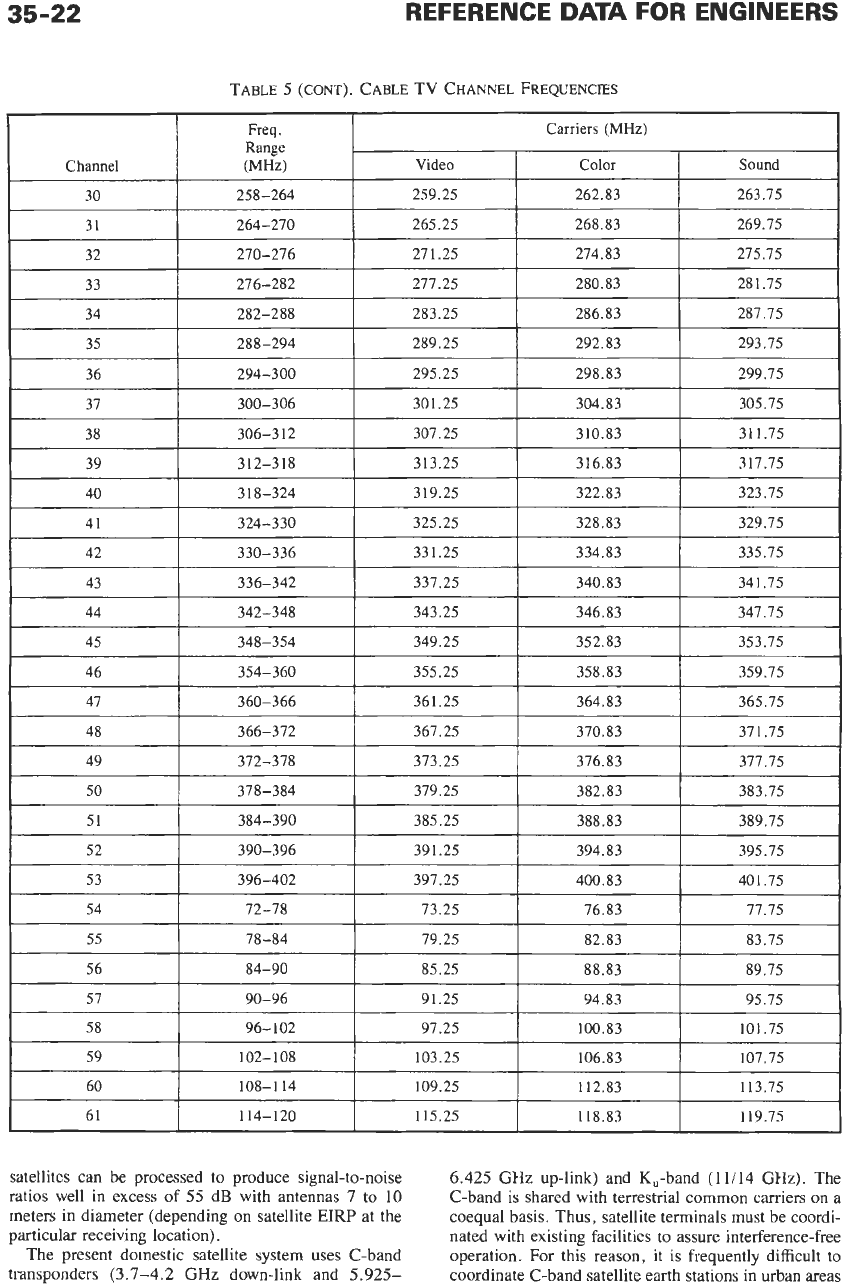
35-22
Channel
TABLE
5
(CONT).
CABLE TV CHANNEL
FREQUENCIES
Freq.
Carriers
(MHz)
Range
(MHz)
Video Color Sound
30
31
32
258-264 259.25 262.83 263.75
264-270 265.25 268.83 269.75
270-276 271.25 274.83 275.75
~
I
33
I
276-282
I
277.25
I
280.83
I
281
I5
I
34
35
36
282-288 283.25 286.83 287.75
288-294 289.25 292.83 293.75
294-300 295.25 298.83 299.75
38
39
40
306-3 12 307.25 310.83 311.75
312-3 18 313.25 316.83 317.75
318-324 319.25 322.83 323.75
41
42
43
44
satellites can be processed to produce signal-to-noise
ratios well
in
excess of
55
dB with antennas 7
to
10
meters in diameter (depending
on
satellite
EIRP
at the
particular receiving location).
The present domestic satellite system uses C-band
transponders (3.7-4.2
GHz
down-link and 5.925-
6.425
GHz
up-link) and K,-band (11/14
GHz).
The
C-band is shared with terrestrial common carriers
on
a
coequal basis. Thus, satellite terminals must be coordi-
nated with existing facilities
to
assure interference-free
operation. For this reason, it is frequently difficult to
coordinate C-band satellite earth stations in urban areas
324-330 325.25 328.83 329.75
330-336 331.25 334.83 335.75
336-342 337.25 340.83 341.75
342-348 343.25 346.83 347.75
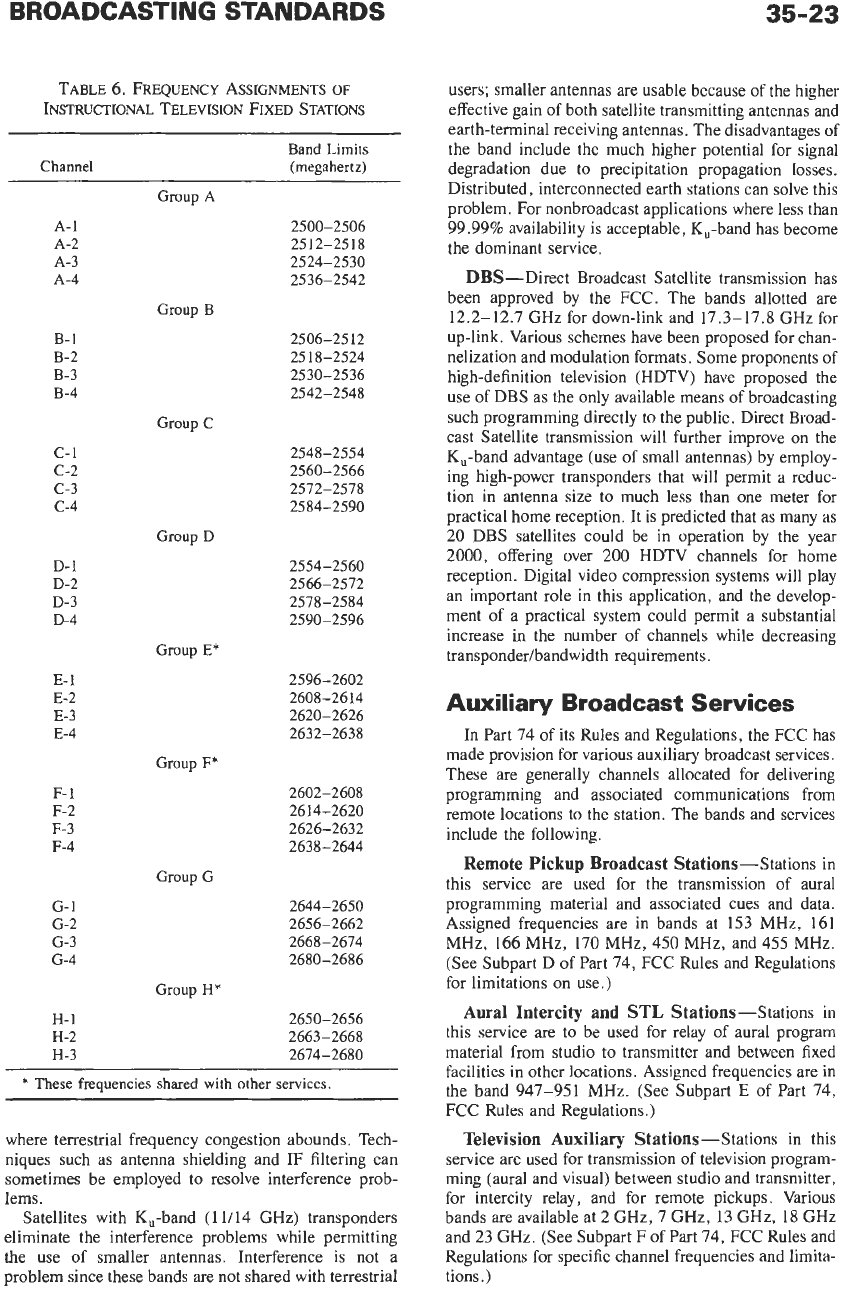
BROADCASTING STANDARDS
35-23
TABLE 6. FREQUENCY ASSIGNMENTS
OF
INSTRUCTIONAL TELEVISION FIXED STATIONS
Band Limits
Channel (megahertz)
users; smaller antennas are usable because of the higher
effective gain of both satellite transmitting antennas and
earth-terminal receiving antennas. The disadvantages
of
the band include the much higher potential for signal
degradation due to precipitation propagation losses.
Distributed, interconnected earth stations can solve this
problem. For nonbroadcast applications where less than
99.99%
availability is acceptable, K,-band has become
the dominant service.
Group
A
A-
1
A-2
A-3
A-4
2500-2506
25 12-2518
2524-2530
2536-2542
DBS-Direct Broadcast Satellite transmission has
been approved by the FCC. The bands allotted are
12.2-12.7 GHz for down-link and 17.3-17.8 GHz for
up-link. Various schemes have been proposed for chan-
nelization and modulation formats. Some proponents of
high-definition television (HDTV) have proposed the
use of DBS as the only available means of broadcasting
such programming directly to the public. Direct Broad-
cast Satellite transmission will further improve on the
&-band advantage (use of small antennas) by employ-
ing high-power transponders that will permit a reduc-
tion in antenna size to much less than one meter for
practical home reception. It is predicted that as many as
20 DBS satellites could be in operation by the year
2000, offering over 200 HDTV channels for home
reception. Digital video compression systems will play
an important role in this application, and the develop-
ment of a practical system could permit a substantial
increase in the number of channels while decreasing
transpondedbandwidth requirements.
Group
B
2506-2512
2518-2524
2530-2536
2542-2548
B-
1
B-3
B-2
B-4
Group
C
c-
1
c-2
c-3
c-4
2548-2554
2512-2518
2584-2590
2560-2566
Group
D
2554-2560
2566-2512
2518-2584
2590-2596
D-
1
D-2
D-4
D-3
Group
E*
E- 1
E-2
E-3
E-4
2596-2602
2608-2614
2620-2626
2632-2638
Auxiliary Broadcast Services
In Part 74 of its Rules and Regulations, the FCC has
made provision for various auxiliary broadcast services.
These are generally channels allocated for delivering
programming and associated communications from
remote locations to the station. The bands and services
include the following.
Group
F*
2602-2608
26 14-2620
2626-2632
2638-2644
F- 1
F-2
F-3
F-4
Remote Pickup Broadcast Stations-Stations in
this service are used for the transmission of aural
programming material and associated cues and data.
Assigned frequencies are in bands at 153 MHz, 161
MHz, 166 MHz, 170 MHz, 450 MHz, and
455
MHz.
(See Subpart D of Part 74, FCC Rules and Regulations
for limitations on use.)
Group
G
G-
1
G-2
G-3
G-4
2644-2650
2656-2662
2668-2614
2680-2686
Group
H*
Aural Intercity and
STL
Stations-Stations in
this service are to be used for relay of aural program
material from studio to transmitter and between fixed
facilities in other locations. Assigned frequencies are in
the band 947-951 MHz. (See Subpart
E
of Part 74,
FCC Rules and Regulations.)
2650-2656
2663-2668
2614-2680
H-
1
H-2
H-3
*
These freauencies shared
with
other services.
where terrestrial frequency congestion abounds. Tech-
niques such as antenna shielding and
IF
filtering can
sometimes be employed to resolve interference prob-
lems.
Satellites with K,-band (1 1/14 GHz) transponders
eliminate the interference problems while permitting
the use
of
smaller antennas. Interference is not a
problem since these bands are not shared with terrestrial
Television Auxiliary Stations-Stations in this
service are used for transmission of television program-
ming (aural and visual) between studio and transmitter,
for intercity relay, and for remote pickups. Various
bands are available at 2 GHz, 7 GHz, 13 GHz, 18 GHz
and 23 GHz. (See Subpart
F
of Part 74, FCC Rules and
Regulations for specific channel frequencies and limita-
tions.)
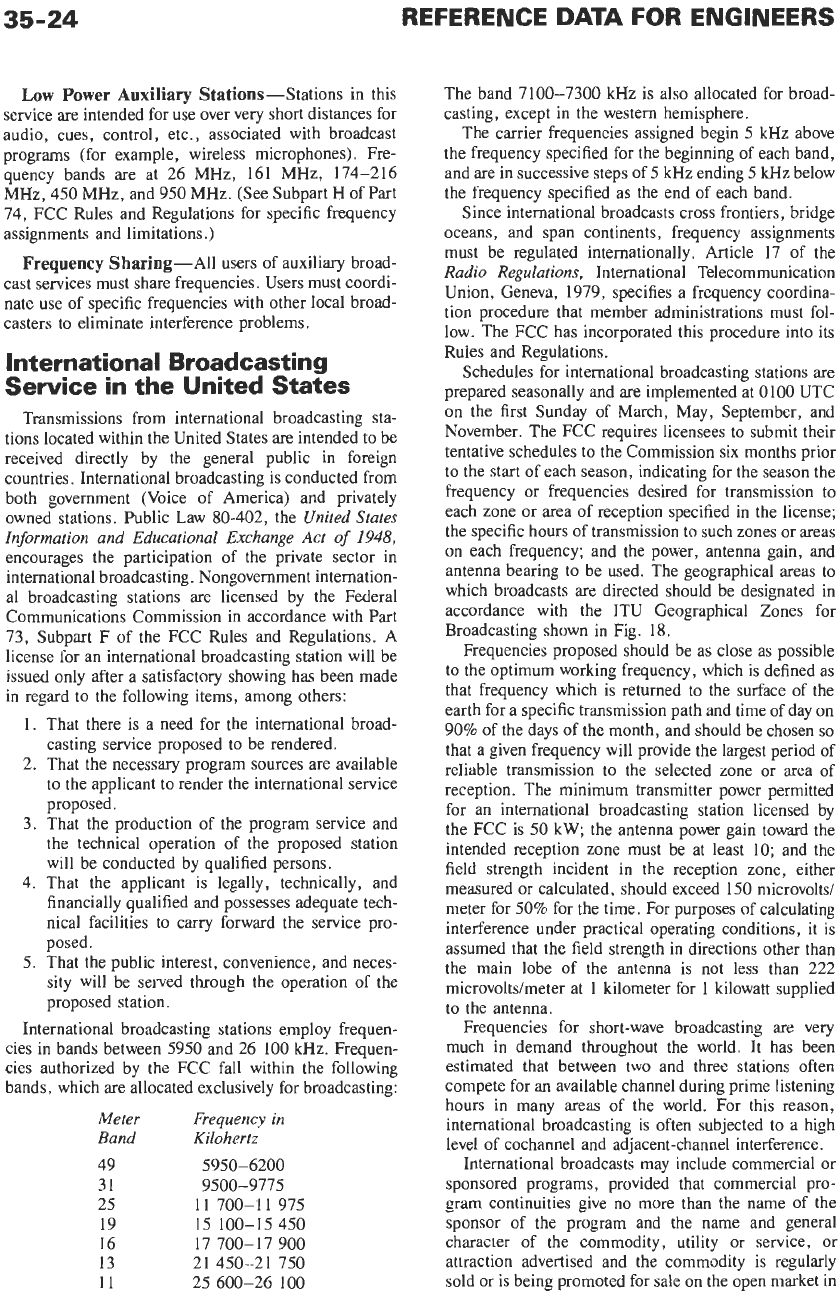
35-24
REFERENCE
DATA
FOR ENGINEERS
Low Power
Auxiliary Stations-Stations in this
service are intended for use over very short distances for
audio, cues, control, etc., associated with broadcast
programs (for example, wireless microphones). Fre-
quency bands are at
26 MHz, 161 MHz, 174-216
MHz, 450 MHz,
and
950
MHz.
(See Subpart
H
of Part
74,
FCC Rules and Regulations for specific frequency
assignments and limitations.)
Frequency
Sharing-
All users of auxiliary broad-
cast services must share frequencies. Users must coordi-
nate use of specific frequencies with other local broad-
casters to eliminate interference problems.
International Broadcasting
Service in the United States
Transmissions from international broadcasting sta-
tions located within the United States are intended to be
received directly by the general public in foreign
countries. International broadcasting is conducted from
both government (Voice of America) and privately
owned stations. Public Law
80-402,
the
United States
Information
and
Educational Exchange Act
of
1948,
encourages the participation of the private sector in
international broadcasting. Nongovernment internation-
al broadcasting stations are licensed by the Federal
Communications Commission in accordance with Part
73,
Subpart F of the FCC Rules and Regulations.
A
license for an international broadcasting station will be
issued only after a satisfactory showing has been made
in regard to the following items, among others:
1.
That there is a need for the international broad-
casting service proposed to be rendered.
2.
That the necessary program sources are available
to the applicant
to
render the international service
proposed.
3.
That the production of the program service and
the technical operation of the proposed station
will be conducted by qualified persons.
4.
That the applicant is legally, technically, and
financially qualified and possesses adequate tech-
nical facilities to carry forward the service pro-
posed.
5.
That the public interest, convenience, and neces-
sity will be served through the operation of the
proposed station.
International broadcasting stations employ frequen-
cies in bands between
5950
and
26
100
kHz. Frequen-
cies authorized by the FCC fall within the following
bands, which are allocated exclusively for broadcasting:
Meter
Band
49
31
25
19
16
13
11
Frequency
in
Kilohertz
5950-6200
9500-9775
11 700-11 975
15
100-15 450
17 700-17 900
21 450-21 750
25
600-26
100
The band
7100-7300
kHz
is also allocated for broad-
casting, except in the western hemisphere.
The carrier frequencies assigned begin
5
kHz above
the frequency specified for the beginning of each band,
and are in successive steps of
5
lcHz
ending
5
kHz
below
the frequency specified as the end
of
each band.
Since international broadcasts cross frontiers, bridge
oceans, and span continents, frequency assignments
must be regulated internationally. Article
17
of the
Radio Regulations,
International Telecommunication
Union, Geneva,
1979,
specifies a frequency coordina-
tion procedure that member administrations must fol-
low. The FCC has incorporated this procedure into its
Rules and Regulations.
Schedules for international broadcasting stations are
prepared seasonally and are implemented at
0100
UTC
on the first Sunday of March, May, September, and
November. The FCC requires licensees to submit their
tentative schedules to the Commission six months prior
to the start of each season, indicating for the season the
frequency or frequencies desired for transmission to
each zone or area of reception specified in the license;
the specific hours of transmission to such zones or areas
on each frequency; and the power, antenna gain, and
antenna bearing to be used. The geographical areas
to
which broadcasts are directed should be designated in
accordance with the ITU Geographical Zones for
Broadcasting shown in Fig.
18.
Frequencies proposed should be as close as possible
to the optimum working frequency, which is defined as
that frequency which is returned to the surface
of
the
earth for a specific transmission path and time of day on
90%
of
the days of the month, and should be chosen
so
that a given frequency will provide the largest period of
reliable transmission to the selected zone or area
of
reception. The minimum transmitter power permitted
for an international broadcasting station licensed by
the FCC is
50
kW;
the antenna power gain toward the
intended reception zone must be at least
10;
and the
field strength incident in the reception zone, either
measured or calculated, should exceed
150
microvolts/
meter for
50%
for the time. For purposes
of
calculating
interference under practical operating conditions, it
is
assumed that the field strength in directions other than
the main lobe of the antenna is not less than
222
microvoltdmeter at
1
kilometer for
1
kilowatt supplied
to the antenna.
Frequencies for short-wave broadcasting are very
much in demand throughout the world. It has been
estimated that between two and three stations often
compete for
an
available channel during prime listening
hours in many areas of the world. For this reason,
international broadcasting is often subjected to a high
level of cochannel and adjacent-channel interference.
International broadcasts may include commercial or
sponsored programs, provided that commercial pro-
gram continuities give no more than the name of the
sponsor of the program and the name and general
character of the commodity, utility or service, or
attraction advertised and the commodity is regularly
sold or is being promoted for sale on the open market in
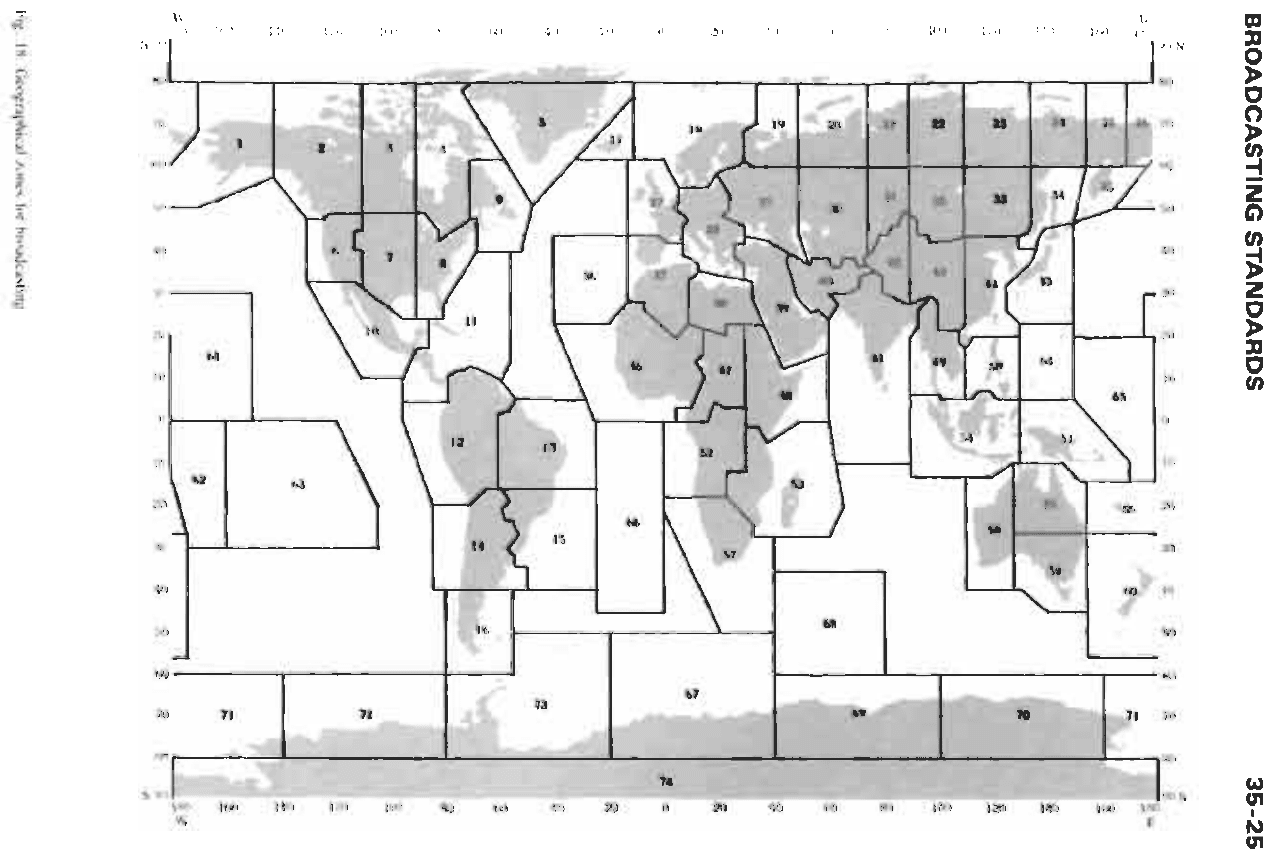
BROADCASTING STANDARDS
35-25
'(I
R
0
R
0
U
0
iD
8
Fig.
18.
Geographical zones
for
broadcasting.
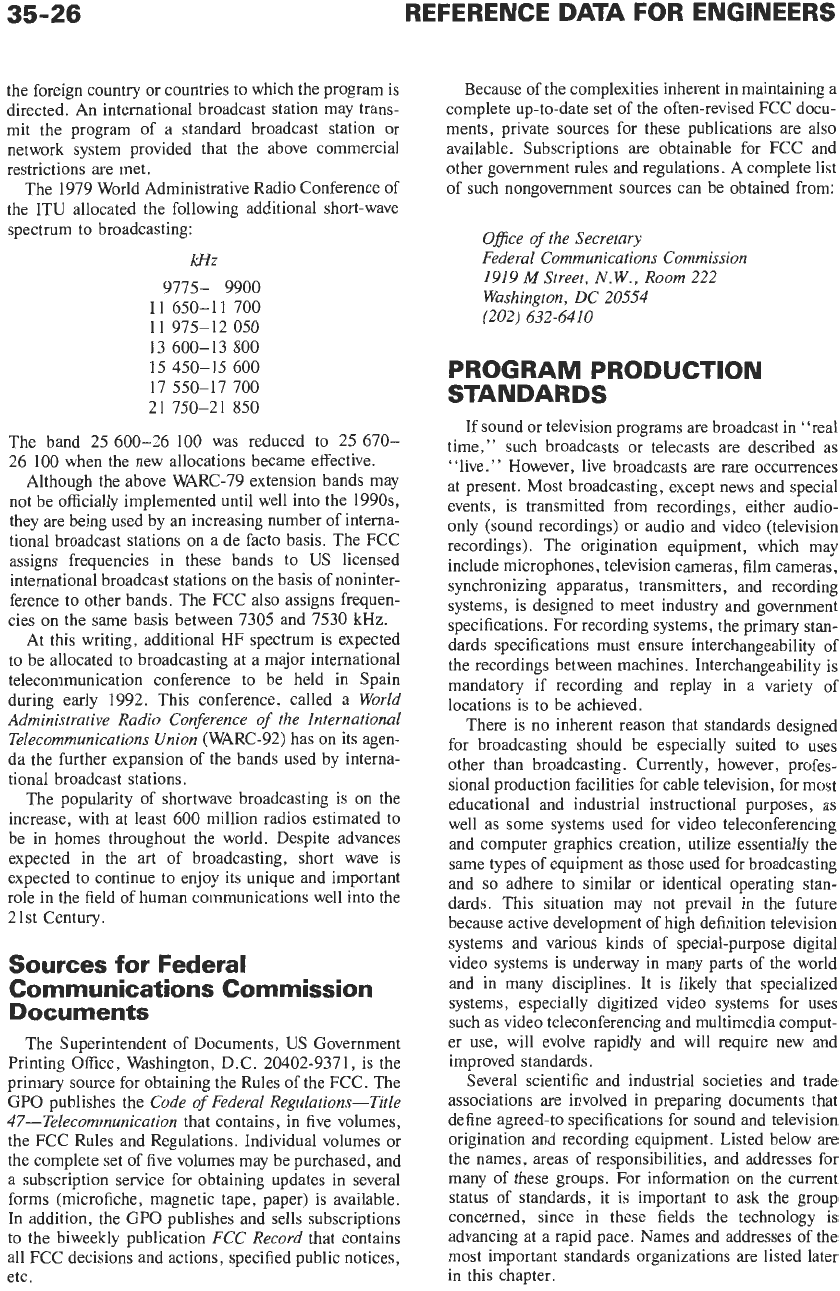
REFERENCE DATA FOR ENGINEERS
the foreign country or countries to which the program is
directed. An international broadcast station may trans-
mit the program of a standard broadcast station or
network system provided that the above commercial
restrictions are met.
The 1979 World Administrative Radio Conference of
the ITU allocated the following additional short-wave
spectrum to broadcasting:
kHZ
9775- 9900
1
1
650-1 1 700
11 975-12
050
13 600-13
800
15 450-15 600
17550-17700
21 750-21
850
The band 25 600-26
100
was reduced to 25 670-
26
100
when the new allocations became effective.
Although the above WARC-79 extension bands may
not be officially implemented until well into the 1990s,
they are being used by an increasing number of interna-
tional broadcast stations
on
a de facto basis. The FCC
assigns frequencies in these bands to
US
licensed
international broadcast stations on the basis of noninter-
ference to other bands. The FCC also assigns frequen-
cies on the same basis between 7305 and 7530 kHz.
At this writing, additional HF spectrum is expected
to be allocated to broadcasting at a major international
telecommunication conference to be held in Spain
during early 1992. This conference, called a
World
Administrative Radio Conference
of
the International
Telecommunications Union
(WARC-92) has on its agen-
da the further expansion
of
the bands used by interna-
tional broadcast stations.
The popularity of shortwave broadcasting is on the
increase, with at least 600 million radios estimated to
be in homes throughout the world. Despite advances
expected in the art
of
broadcasting, short wave is
expected
to
continue to enjoy its unique and important
role in the field of human communications well into the
21st Century.
Sources for Federal
Communications Commission
Documents
The Superintendent of Documents,
US
Government
Printing Office, Washington, D.C. 20402-9371, is the
primary source for obtaining the Rules of the FCC. The
GPO publishes the
Code
of
Federal Regulations-Title
47-Telecommunication
that contains, in five volumes,
the FCC Rules and Regulations. Individual volumes or
the complete set of five volumes may be purchased, and
a subscription service for obtaining updates in several
forms (microfiche, magnetic tape, paper) is available.
In
addition, the
GPO
publishes and sells subscriptions
to the biweekly publication
FCC Record
that contains
all FCC decisions and actions, specified public notices,
etc
.
Because
of
the complexities inherent in maintaining a
complete up-to-date set of the often-revised FCC docu-
ments, private sources for these publications are also
available. Subscriptions are obtainable for FCC and
other government rules and regulations. A complete list
of such nongovernment sources can be obtained from:
Ofice of the Secretary
Federal Communications Commission
1919
M
Street, N.W., Room 222
Washington, DC 20554
(202) 632-6410
PROGRAM PRODUCTION
STANDARDS
If sound or television programs are broadcast in “real
time,” such broadcasts or telecasts are described as
“live.” However, live broadcasts are rare occurrences
at present. Most broadcasting, except news and special
events, is transmitted from recordings, either audio-
only (sound recordings) or audio and video (television
recordings). The origination equipment, which may
include microphones, television cameras, film cameras,
synchronizing apparatus, transmitters, and recording
systems, is designed to meet industry and government
specifications. For recording systems, the primary stan-
dards specifications must ensure interchangeability of
the recordings between machines. Interchangeability is
mandatory if recording and replay in a variety of
locations is to be achieved.
There is no inherent reason that standards designed
for broadcasting should be especially suited to uses
other than broadcasting. Currently, however, profes-
sional production facilities for cable television, for most
educational and industrial instructional purposes, as
well as some systems used for video teleconferencing
and computer graphics creation, utilize essentially the
same types of equipment as those used for broadcasting
and
so
adhere to similar or identical operating stan-
dards. This situation may not prevail in the future
because active development of high definition television
systems and various kinds of special-purpose digital
video systems is underway in many parts of the world
and in many disciplines. It is likely that specialized
systems, especially digitized video systems for uses
such as video teleconferencing and multimedia comput-
er use, will evolve rapidly and will require new and
improved standards.
Several scientific and industrial societies and trade
associations are involved in preparing documents that
define agreed-to specifications for sound and television
origination and recording equipment. Listed below are
the names, areas of responsibilities, and addresses for
many of these groups. For information on the current
status of standards, it is important to ask the group
concerned, since in these fields the technology
is
advancing at a rapid pace. Names and addresses of the
most important standards organizations are listed later
in this chapter.
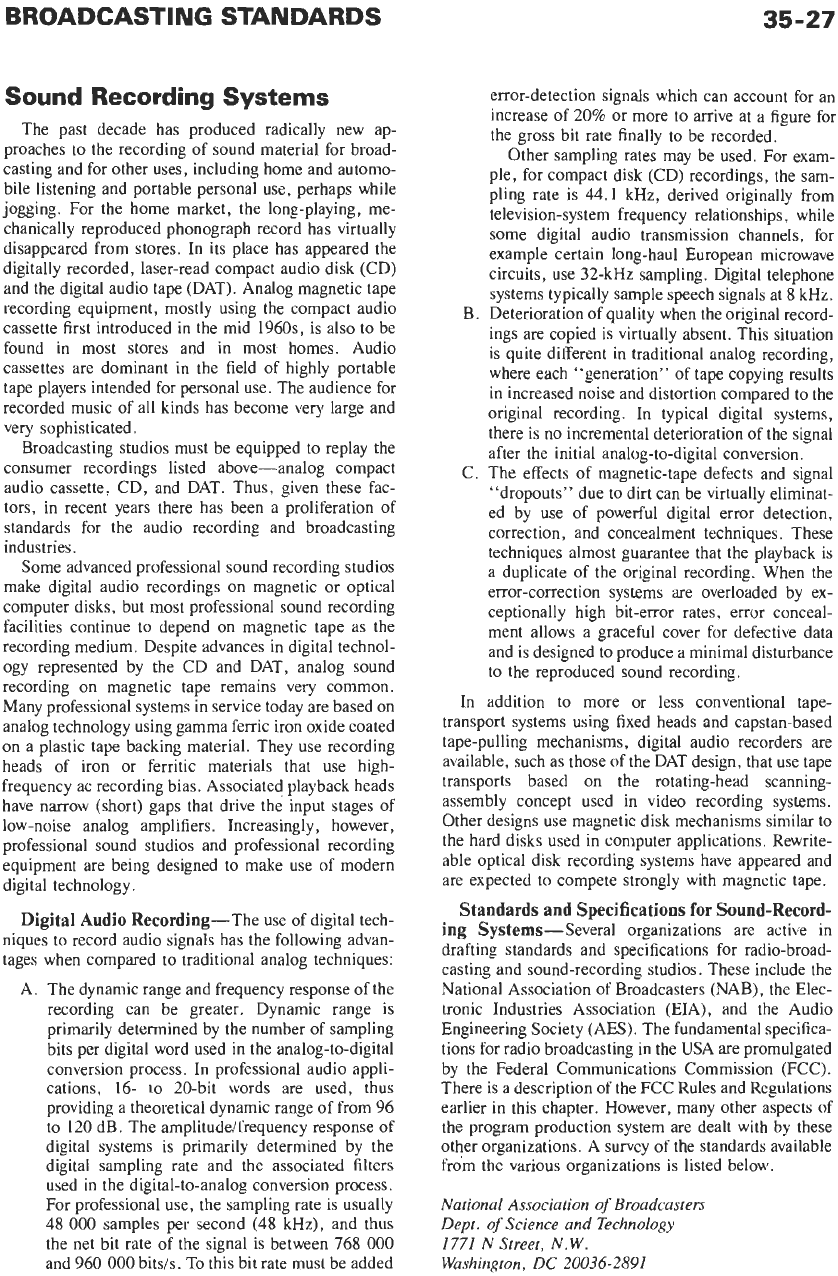
BROADCASTING STANDARDS
35-27
Sound Recording Systems
The past decade has produced radically new ap-
proaches to the recording of sound material for broad-
casting and for other uses, including home and automo-
bile listening and portable personal use, perhaps while
jogging. For the home market, the long-playing, me-
chanically reproduced phonograph record has virtually
disappeared from stores. In its place has appeared the
digitally recorded, laser-read compact audio disk (CD)
and the digital audio tape (DAT). Analog magnetic tape
recording equipment, mostly using the compact audio
cassette first introduced in the mid 196Os, is also to be
found in most stores and in most homes. Audio
cassettes are dominant in the field
of
highly portable
tape players intended for personal use. The audience for
recorded music of all kinds has become very large and
very sophisticated.
Broadcasting studios must be equipped to replay the
consumer recordings listed above-analog compact
audio cassette, CD, and DAT. Thus, given these fac-
tors, in recent years there has been a proliferation
of
standards for the audio recording and broadcasting
industries.
Some advanced professional sound recording studios
make digital audio recordings on magnetic or optical
computer disks, but most professional sound recording
facilities continue to depend on magnetic tape as the
recording medium. Despite advances in digital technol-
ogy represented by the CD and DAT, analog sound
recording
on
magnetic tape remains very common.
Many professional systems in service today are based on
analog technology using gamma ferric iron oxide coated
on a plastic tape backing material. They use recording
heads of iron or ferritic materials that use high-
frequency ac recording bias. Associated playback heads
have narrow (short) gaps that drive the input stages of
low-noise analog amplifiers. Increasingly, however,
professional sound studios and professional recording
equipment are being designed to make use of modern
digital technology.
Digital Audio Recording-The use of digital tech-
niques to record audio signals has the following advan-
tages when compared to traditional analog techniques:
A. The dynamic range and frequency response of the
recording can be greater. Dynamic range is
primarily determined by the number of sampling
bits per digital word used in the analog-to-digital
conversion process. In professional audio appli-
cations, 16- to 20-bit words are used, thus
providing a theoretical dynamic range of from 96
to
120
dB. The amplitudeifrequency response of
digital systems is primarily determined by the
digital sampling rate and the associated filters
used in the digital-to-analog conversion process.
For professional use, the sampling rate is usually
48
000
samples per second (48 kHz), and thus
the net bit rate of the signal is between 768
000
and 960
000
bits/s. To this bit rate must be added
error-detection signals which can account for an
increase of
20%
or more to arrive at a figure for
the gross bit rate finally to be recorded.
Other sampling rates may be used. For exam-
ple, for compact disk (CD) recordings, the
sam-
pling rate is
44.1
kHz, derived originally from
television-system frequency relationships, while
some digital audio transmission channels, for
example certain long-haul European microwave
circuits, use 32-kHz sampling. Digital telephone
systems typically sample speech signals at 8 kHz.
Deterioration of quality when the original record-
ings are copied is virtually absent. This situation
is quite different in traditional analog recording,
where each “generation” of tape copying results
in increased noise and distortion compared to the
original recording. In typical digital systems,
there is no incremental deterioration of the signal
after the initial analog-to-digital conversion.
The effects
of
magnetic-tape defects and signal
“dropouts” due to dirt can be virtually eliminat-
ed by use of powerful digital error detection,
correction, and concealment techniques. These
techniques almost guarantee that the playback is
a duplicate of the original recording. When the
error-correction systems are overloaded by ex-
ceptionally high bit-error rates, error conceal-
ment allows a graceful cover for defective data
and is designed to produce a minimal disturbance
to the reproduced sound recording.
addition to more or less conventional tape-
transport systems using fixed heads and capstan-based
tape-pulling mechanisms, digital audio recorders are
available, such as those of the DAT design, that use tape
transports based on the rotating-head scanning-
assembly concept used in video recording systems.
Other designs use magnetic disk mechanisms similar to
the hard disks used in computer applications. Rewrite-
able optical disk recording systems have appeared and
are expected to compete strongly with magnetic tape.
Standards and Specifications for Sound-Record-
ing Systems-Several organizations are active in
drafting standards and specifications for radio-broad-
casting and sound-recording studios. These include the
National Association of Broadcasters (NAB), the Elec-
tronic Industries Association (EIA), and the Audio
Engineering Society (AES), The fundamental specifica-
tions for radio broadcasting in the USA are promulgated
by the Federal Communications Commission (FCC).
There is a description of the FCC Rules and Regulations
earlier in this chapter. However, many other aspects of
the program production system are dealt with by these
other organizations. A survey of the standards available
from the various organizations is listed below.
National Association
of
Broadcasters
Dept.
of
Science and Technology
1771
N Street, N.W.
Washington,
DC
20036-2891
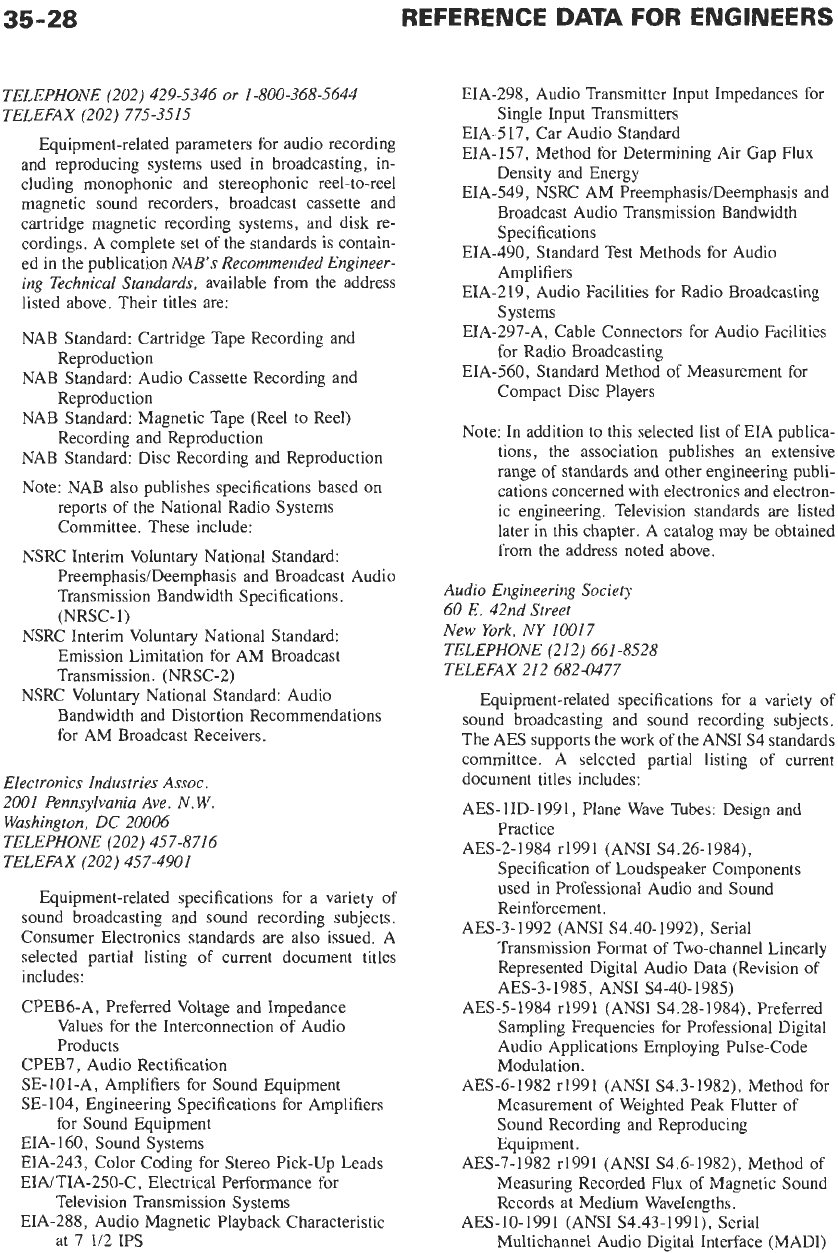
TELEPHONE (202) 429-5346 or 1-800-368-5644
TELEFAX (202) 775-3515
Equipment-related parameters for audio recording
and reproducing systems used in broadcasting, in-
cluding monophonic and stereophonic reel-to-reel
magnetic sound recorders, broadcast cassette and
cartridge magnetic recording systems, and disk re-
cordings. A complete set of the standards is contain-
ed in the publication
NAB’S Recommended Engineer-
ing Technical Standards,
available from the address
listed above. Their titles are:
NAB Standard: Cartridge Tape Recording and
NAB Standard: Audio Cassette Recording and
NAB Standard: Magnetic Tape (Reel to Reel)
NAB Standard: Disc Recording and Reproduction
Note: NAB also publishes specifications based on
reports of the National Radio Systems
Committee. These include:
NSRC Interim Voluntary National Standard:
Preemphasis/Deemphasis and Broadcast Audio
Transmission Bandwidth Specifications.
NSRC Interim Voluntary National Standard:
Emission Limitation for AM Broadcast
Transmission. (NRSC-2)
Bandwidth and Distortion Recommendations
for AM Broadcast Receivers.
Reproduction
Reproduction
Recording and Reproduction
(NRSC-1)
NSRC Voluntary National Standard: Audio
Electronics Industries
Assoc.
2001 Pennsylvania Ave. N.
W.
Washington,
DC
20006
TELEPHONE (202) 457-8716
TELEFAX (202) 457-4901
Equipment-related specifications for a variety of
sound broadcasting and sound recording subjects.
Consumer Electronics standards are also issued. A
selected partial listing of current document titles
includes:
CPEB6-A, Preferred Voltage and Impedance
Values for the Interconnection of Audio
Products
CPEB7, Audio Rectification
SE-101-A, Amplifiers for Sound Equipment
SE- 104, Engineering Specifications for Amplifiers
EIA-160, Sound Systems
EIA-243, Color Coding for Stereo Pick-Up Leads
EIA/TIA-250-C, Electrical Performance for
EIA-288, Audio Magnetic Playback Characteristic
for Sound Equipment
Television Transmission Systems
at 7
1/2
IPS
EIA-298, Audio Transmitter Input Impedances for
Single Input Transmitters
EIA-.517, Car Audio Standard
EIA-157, Method for Determining Air Gap
Flux
Density and Energy
EIA-549, NSRC AM Preemphasis/Deemphasis and
Broadcast Audio Transmission Bandwidth
Specifications
Amplifiers
Systems
for Radio Broadcasting
Compact Disc Players
EIA-490, Standard Test Methods for Audio
EIA-219, Audio Facilities for Radio Broadcasting
EIA-297-A, Cable Connectors for Audio Facilities
EIA-560, Standard Method of Measurement for
Note: In addition to this selected list
of
EIA publica-
tions, the association publishes an extensive
range of standards and other engineering publi-
cations concerned with electronics and electron-
ic engineering. Television standards are listed
later in this chapter. A catalog may be obtained
from the address noted above.
Audio
Engineering Society
60 E. 42nd Street
New York, NY 10017
TELEPHONE (212) 661 -8528
TELEFAX 212 682-0477
Equipment-related specifications for a variety
of
sound broadcasting and sound recording subjects.
The AES supports the work
of
the ANSI S4 standards
committee.
A
selected partial listing of current
document titles includes:
AES-IID-1951, Plane Wave Tubes: Design and
AES-2-1984 r1991 (ANSI S4.26-1984),
Practice
Specification of Loudspeaker Components
used in Professional Audio and Sound
Reinforcement.
Transmission Format
of
Two-channel Linearly
Represented Digital Audio Data (Revision of
AES-3-1985, ANSI S4-40-1985)
AES-5-1984 r1991 (ANSI S4.28-1984), Preferred
Sampling Frequencies for Professional Digital
Audio Applications Employing Pulse-Code
Modulation.
AES-6-1982 r1991 (ANSI S4.3-1982), Method for
Measurement of Weighted Peak Flutter
of
Sound Recording and Reproducing
Equipment.
AES-7-1982 r1991 (ANSI S4.6-1982), Method of
Measuring Recorded
Flux
of Magnetic Sound
Records at Medium Wavelengths.
AES-
10-
199
1
(ANSI S4.43- 199 l), Serial
Multichannel Audio Digital Interface (MADI)
AES-3-1992 (ANSI S4.40-1992), Serial

BROADCAST1 NG STANDARDS
35-29
AES-
1
1-1991 (ANSI S4.44-1991), Synchronization
of Digital Audio Equipment in Studio
Operations.
AES-14-1992 (ANSI 4.48-1992), Application of
Connectors, Part 1: XLR Polarity and Gender.
AES-15-1991 (ANSI S4.49-1991), Sound
Reinforcement Systems-Communications
Interface (PA 422)
AES- 17- 199 1 (ANSI S4.50- 199
l),
Measurement
of Digital Audio Equipment.
AES-18-1992 (ANSI S4.52-1992), Format for the
User Data Channel of the AES Digital Audio
Interface.
AES-19-1992 (ANSI S4.30-1992), Measurement
of the Lowest Resonance Frequency of
Loudspeaker Cones.
Note: The Audio Engineering Society provides a
computer-based data exchange that may be
accessed by modem. It provides fully updated
information on AES standards. Details for
accessing this facility may be obtained from the
AES headquarters listed above.
International Sound-Recording Standards-
The contents of most of the standards and specifications
listed above are duplicated in international standards.
For sound recording, international standardization is
performed by the International Electrotechnical Com-
mission (IEC), a subdivision of the International Stan-
dards Organization (ISO). Responsibility for interna-
tional sound-recording standards rests with the IEC
Technical Committee 60-Recording (TC-60) and its
subcommittee SC-60A. Loudspeakers, microphones,
and audio-visual systems are standardized by TC-84.
Information on IEC and
IS0
standards may be
obtained from:
American National Standards Institute
1430
Broadway
New York, NY 10018
International exchange of recorded broadcast sound
programs is dealt with by the International Radio
Consultative Committee (CCIR). Copies of CCIR doc-
uments may be ordered from:
National Technical Information Service
US
Department of Commerce
5285
Port
Royal Road,
Box
1553
Springfield,
VA
22161
A listing of international standards affecting sound
broadcasting is given in the section “International
Standards
for
Broadcasting” at the end
of
this chapter.
Television Recording Systems
The recording of television signals on magnetic tape,
variously described as video tape recording (VTR) or
television recording, is a technology that has been used
professionally for about 35 years. The invention of the
video recorder ranks high among the important techni-
cal and cultural developments of the 20th century.
Various recording formats are now in professional
service. They include the original broadcast format
using 2-inch-wide tape (now essentially obsolete) and
formats using 1-inch tape, %-inch tape, 19-mm tape,
and Yz-inch tape. The last three tape widths are used for
both analog and digital video recording systems, with
the tape contained in a box called a cassette. Digital
video recording will surely become the dominant pro-
fessional technology in the immediate future. In addi-
tion to these professional formats, there are hundreds of
millions of video cassette recorders (VCRs) in homes
and institutions around the world. In general, VCR
systems use analog recording technology and %-inch or
8-mm tape. The tape itself is contained in a cassette that
is inserted into the front of the recording machine.
Among the formats listed above, all except the
obsolete 2-inch format use helical recording technolo-
gy. In this system, the tape is constrained by mechani-
cal guides
to
take the shape
of
a partial helix and is
wrapped around a cylinder (the scanner) that rotates
rapidly. The scanner also serves as a mounting for the
video recording head(s). The tracks that result from the
recording process are placed very closely together and at
a shallow angle of a degree or two to the reference tape
edge. The tracks are quite long, their length amounting
to ten or more times the width of the tape. Because the
cylinder around which the tape is wrapped rotates
rapidly, usually in the 3500-3600 rimin range, the
wavelength of the highest recorded modulation frequen-
cy (or of a recorded digital data symbol) ranges from
0.7 to 1.1 micron and is well accommodated by the
magnetic recording process.
Older recording machine designs, like the 1-inch
Type C analog composite helical recorder, use a reel-to-
reel tape transport system, where two reels or spools
serve to hold the tape in position for passage through the
transport mechanism. The tape moves from the supply
reel through the recording heads and onto the takeup
reel. In all the other listed formats, the tape is contained
in a plastic box called a cassette. For recording or
playback use, the cassette is inserted into a loading slot
in a recording or playing system. The tape is automati-
cally extracted through a slot in the front of the cassette
and guided around the helical recording assembly.
When this loading process is completed, the machine is
ready to receive the commands needed to record or
replay a tape.
Professional video recording systems are standard-
ized in North America by the SMPTE (Society of
Motion Picture and Television Engineers) and interna-
tionally by Technical Committee 60-Recording of the
IEC (International Electrotechnical Commission). The
1-inch SMPTE Type C composite recorder has been
very heavily used for broadcasting and program produc-
tion. This format uses full bandwidth FM recording,
where the incoming video signal, in composite form,
is
frequency modulated onto an RF carrier which is then
directly recorded on tape. For news gathering and other
portable applications, the BetaCamTM and M-IITM
analog component systems are frequently used.
As
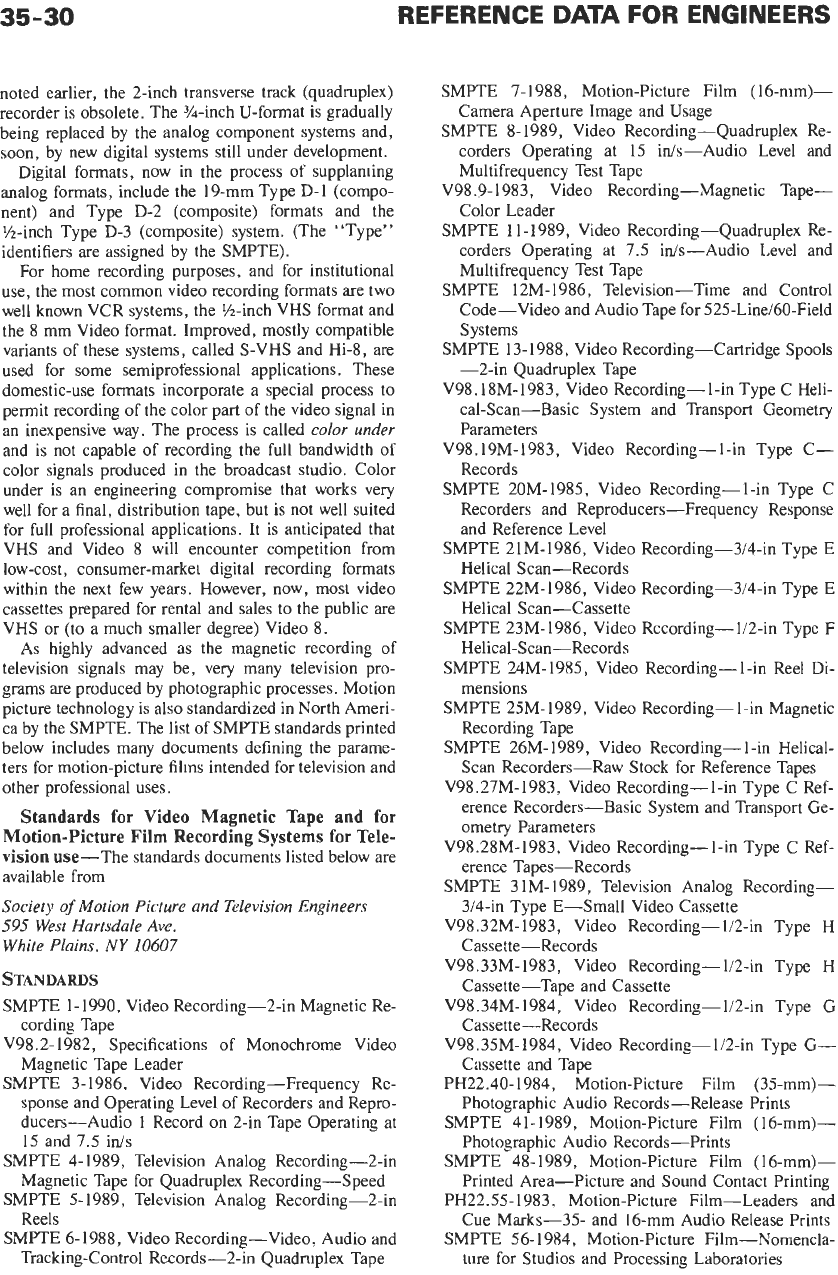
noted earlier, the 2-inch transverse track (quadruplex)
recorder is obsolete. The %-inch U-format
is
gradually
being replaced by the analog component systems and,
soon, by new digital systems still under development.
Digital formats, now in the process of supplanting
analog formats, include the 19-mm Type
D-1
(compo-
nent) and Type D-2 (composite) formats and the
%-inch Type D-3 (composite) system. (The “Type”
identifiers are assigned by the SMPTE).
For home recording purposes, and for institutional
use, the most common video recording formats are two
well known VCR systems, the %-inch VHS format and
the
8
mm Video format. Improved, mostly compatible
variants of these systems, called S-VHS and Hi-8, are
used for some semiprofessional applications. These
domestic-use formats incorporate a special process to
permit recording of the color part of the video signal in
an inexpensive way. The process is called
color
under
and is not capable of recording the full bandwidth of
color signals produced in the broadcast studio. Color
under
is
an engineering compromise that works very
well for a final, distribution tape, but is not well suited
for full professional applications. It is anticipated that
VHS and Video 8 will encounter competition from
low-cost
,
consumer-market digital recording formats
within the next few years. However, now, most video
cassettes prepared for rental and sales to the public are
VHS or (to a much smaller degree) Video
8.
As highly advanced as the magnetic recording of
television signals may be, very many television pro-
grams are produced by photographic processes. Motion
picture technology is also standardized in North Ameri-
ca by the SMPTE. The list of SMPTE standards printed
below includes many documents defining the parame-
ters for motion-picture films intended for television and
other professional uses.
Standards for Video Magnetic Tape and for
Motion-Picture Film Recording Systems for
Tele-
vision use-The standards documents listed below are
available from
Society
of
Motion Picture and Television Engineers
595
West Hartsdale Ave.
White Plains,
NY
10607
STANDARDS
SMPTE
1-
1990, Video Recording-2-in Magnetic Re-
cording Tape
V98.2-1982, Specifications of Monochrome Video
Magnetic Tape Leader
SMPTE 3- 1986, Video Recording-Frequency Re-
sponse and Operating Level of Recorders and Repro-
ducers-Audio
1
Record
on
2-in Tape Operating at
15 and
7.5
in/s
SMPTE 4- 1989, Television Analog Recording-2-in
Magnetic Tape for Quadruplex Recording-Speed
SMPTE
5-
1989, Television Analog Recording-2-in
Reels
SMPTE 6-1988, Video Recording-Video, Audio and
Tracking-Control Records-2-in Quadruplex Tape
SMPTE 7-1988, Motion-Picture Film (16-mm)-
Camera Aperture Image and Usage
SMPTE
8-
1989, Video Recording-Quadruplex Re-
corders Operating at 15 inis-Audio Level and
Multifrequency Test Tape
V98.9-1983, Video Recording-Magnetic Tape-
Color Leader
SMPTE 11 -1989, Video Recording-Quadruplex Re-
corders Operating at 7.5 ids-Audio Level and
Multifrequency Test Tape
SMPTE 12M-1986, Television-Time and Control
Code-Video and Audio Tape for 525-Linei60-Field
Systems
SMPTE 13-1988, Video Recording-Cartridge Spools
-2-in Quadruplex Tape
V98. ISM-1983, Video Recording-I-in Type C Heli-
cal-Scan-Basic System and Transport Geometry
Parameters
V98.19M-1983, Video Recording-1-in Type C-
Records
SMPTE 20M-1985, Video Recording-1-in Type C
Recorders and Reproducers-Frequency Response
and Reference Level
SMPTE 21M-1986, Video Recording-3i4-in Type E
Helical Scan-Records
SMPTE 22M-1986, Video Recording-3i4-in Type E
Helical Scan-Cassette
SMPTE 23M-1986, Video Recording-li2-in Type F
Helical-Scan-Records
SMPTE 24M-1985, Video Recording-I-in Reel Di-
mensions
SMPTE 25M- 1989, Video Recording- 1 -in Magnetic
Recording Tape
SMPTE 26M- 1989, Video Recording- 1-in Helical-
Scan Recorders-Raw Stock for Reference Tapes
V98.27M- 1983, Video Recording- 1 -in Type C Ref-
erence Recorders-Basic System and Transport Ge-
ometry Parameters
V98.28M-1983, Video Recording-1-in Type C Ref-
erence Tapes-Records
SMPTE 3 1 M- 1989, Television Analog Recording-
3/4-in Type E-Small Video Cassette
V98.32M-1983, Video Recording-li2-in Type H
Cassette-Records
V98.33M-1983, Video Recording-li2-in Type
H
Cassette-Tape and Cassette
V98.34M-1984, Video Recording-Ii2-in Type G
Cassette-Records
V98.35M-1984, Video Recording-li2-in Type G-
Cassette and Tape
PH22.40-1984, Motion-Picture Film (35-mm)-
Photographic Audio Records-Release Prints
SMPTE 41-1989, Motion-Picture Film (16-mm)-
Photographic Audio Records-Prints
SMPTE 48-1989, Motion-Picture Film (16-mm)-
Printed Area-Picture and Sound Contact Printing
PH22.55- 1983, Motion-Picture Film-Leaders and
Cue Marks-35- and 16-mm Audio Release Prints
SMPTE 56-1984, Motion-Picture Film-Nomencla-
ture for Studios and Processing Laboratories
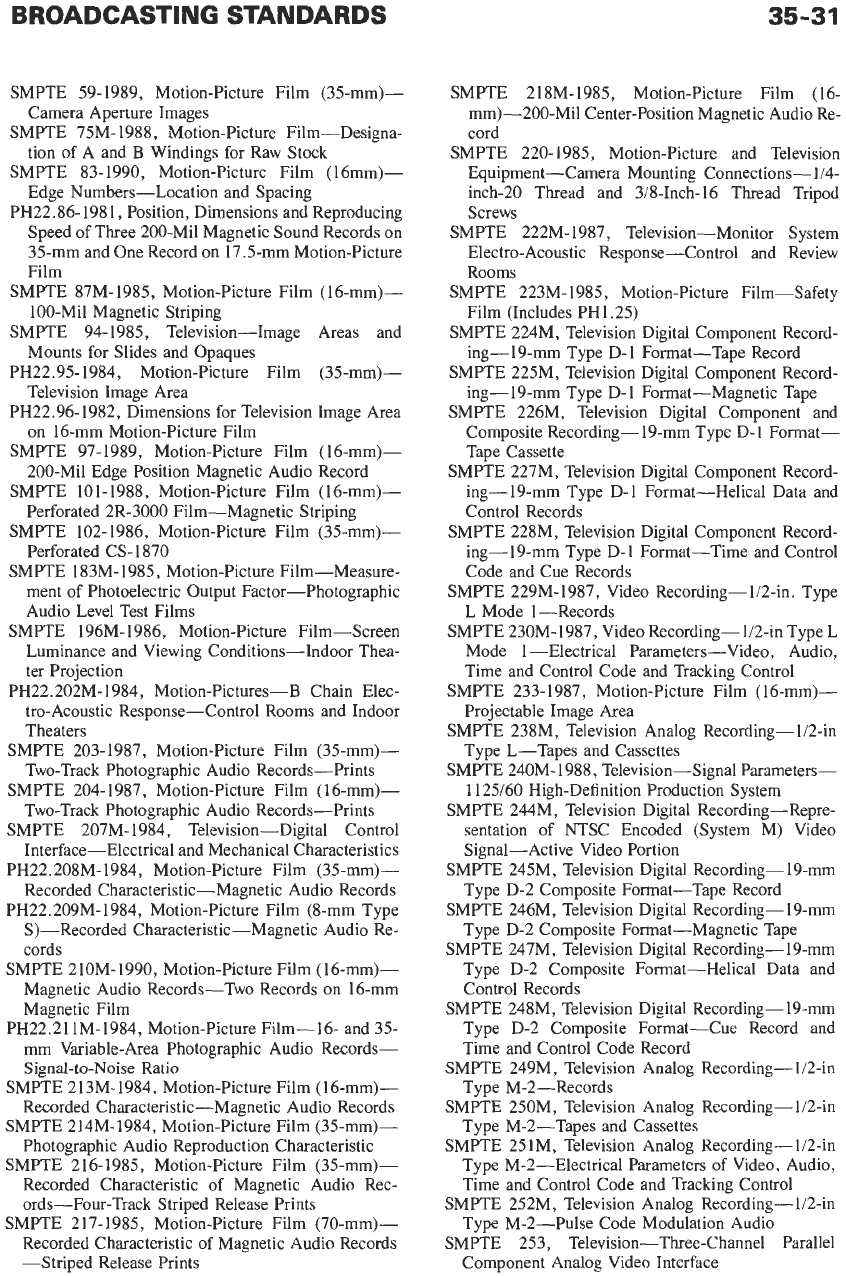
SMPTE 59-1989, Motion-Picture Film (35-mm)-
Camera Aperture Images
SMPTE 75M- 1988, Motion-Picture Film-Designa-
tion of A and
B
Windings for Raw Stock
SMPTE 83-1990, Motion-Picture Film (16mm)-
Edge Numbers-Location and Spacing
PH22.86-198 1, Position, Dimensions and Reproducing
Speed of Three 200-Mil Magnetic Sound Records on
35-mm and One Record on 17.5-mm Motion-Picture
Film
SMPTE 87M-1985, Motion-Picture Film (16-mm)-
100-Mil Magnetic Striping
SMPTE 94-1985, Television-Image Areas and
Mounts for Slides and Opaques
PH22.95- 1984, Motion-Picture Film (35-mm)-
Television Image Area
PH22.96-1982, Dimensions for Television Image Area
on 16-mm Motion-Picture Film
SMPTE 97-1989, Motion-Picture Film (16-mm)-
200-Mil Edge Position Magnetic Audio Record
SMPTE 101-1988, Motion-Picture Film (16-mm)-
Perforated 2R-3000 Film-Magnetic Striping
SMPTE 102-1986, Motion-Picture Film (35-mm)-
Perforated CS-1870
SMPTE 183M- 1985, Motion-Picture Film-Measure-
ment of Photoelectric Output Factor-Photographic
Audio Level Test Films
SMPTE 196M-1986, Motion-Picture Film-Screen
Luminance and Viewing Conditions-Indoor Thea-
ter Projection
PH22.202M-1984, Motion-Pictures-B Chain Elec-
tro-Acoustic Response-Control Rooms and Indoor
Theaters
SMPTE 203-1987, Motion-Picture Film (35-mm)-
Two-Track Photographic Audio Records-Prints
SMPTE 204-1987, Motion-Picture Film (16-mm)-
Two-Track Photographic Audio Records-Prints
SMPTE 207M- 1984, Television-Digital Control
Interface-Electrical and Mechanical Characteristics
PH22.208M-1984, Motion-Picture Film (35-mm)-
Recorded Characteristic-Magnetic Audio Records
PH22.209M-1984, Motion-Picture Film (8-mm Type
S)-Recorded Characteristic-Magnetic Audio Re-
cords
SMPTE 210M-1990, Motion-Picture Film (16-mm)-
Magnetic Audio Records-Two Records on 16-mm
Magnetic Film
PH22.211M-1984, Motion-Picture Film-16- and 35-
mm Variable-Area Photographic Audio Records-
Signal-to-Noise Ratio
SMPTE 213M-1984, Motion-Picture Film (16-mm)-
Recorded Characteristic-Magnetic Audio Records
SMPTE 214M-1984, Motion-Picture Film (35-mm)-
Photographic Audio Reproduction Characteristic
SMPTE 216-1985, Motion-Picture Film (35-mm)-
Recorded Characteristic of Magnetic Audio Rec-
ords-Four-Track Striped Release Prints
SMPTE 217-1985, Motion-Picture Film (70-mm)-
Recorded Characteristic
of
Magnetic Audio Records
-Striped Release Prints
SMPTE 218M-1985, Motion-Picture Film (16-
mm)-200-Mil Center-Position Magnetic Audio Re-
cord
SMPTE 220- 1985, Motion-Picture and Television
Equipment-Camera Mounting Connections-1114-
inch-20 Thread and 3/8-Inch-16 Thread Tripod
Screws
SMPTE 222M- 1987, Television-Monitor System
Electro-Acoustic Response-Control and Review
Rooms
SMPTE 223M-1985, Motion-Picture Film-Safety
Film (Includes PH1.25)
SMPTE 224M, Television Digital Component Record-
ing-19-mm Type D-1 Format-Tape Record
SMPTE 225M, Television Digital Component Record-
ing-19-mm Type D-1 Format-Magnetic Tape
SMPTE 226M, Television Digital Component and
Composite Recording-19-mm Type D-1 Format-
Tape Cassette
SMPTE 227M, Television Digital Component Record-
ing-19-mm Type D-1 Format-Helical Data and
Control Records
SMPTE 228M, Television Digital Component Record-
ing-19-mm Type D-1 Format-Time and Control
Code and Cue Records
SMPTE 229M-1987, Video Recording-li2-in. Type
L Mode 1-Records
SMPTE 230M-1987, Video Recording-li2-in Type L
Mode
1
-Electrical Parameters-Video, Audio,
Time and Control Code and Tracking Control
SMPTE 233-1987, Motion-Picture Film (16-mm)-
Projectable Image Area
SMPTE 238M, Television Analog Recording- li2-in
Type L-Tapes and Cassettes
SMPTE 240M- 1988, Television-Signal Parameters-
1125160 High-Definition Production System
SMPTE 244M, Television Digital Recording-Repre-
sentation
of
NTSC Encoded (System M) Video
Signal-Active Video Portion
SMPTE 245M, Television Digital Recording-19-mm
Type D-2 Composite Format-Tape Record
SMPTE 246M, Television Digital Recording- 19-mm
Type D-2 Composite Format-Magnetic Tape
SMPTE 247M, Television Digital Recording- 19-mm
Type D-2 Composite Format-Helical Data and
Control Records
SMPTE 248M, Television Digital Recording-19-mm
Type D-2 Composite Format-Cue Record and
Time and Control Code Record
SMPTE 249M, Television Analog Recording- li2-in
Type M-2-Records
SMPTE 250M, Television Analog Recording- 1/2-in
Type M-2-Tapes and Cassettes
SMPTE 25 lM, Television Analog Recording-li2-in
Type M-2-Electrical Parameters
of
Video, Audio,
Time and Control Code and Tracking Control
SMPTE 252M, Television Analog Recording-li2-in
Type M-2-Pulse Code Modulation Audio
SMPTE 253, Television-Three-Channel Parallel
Component Analog Video Interface
